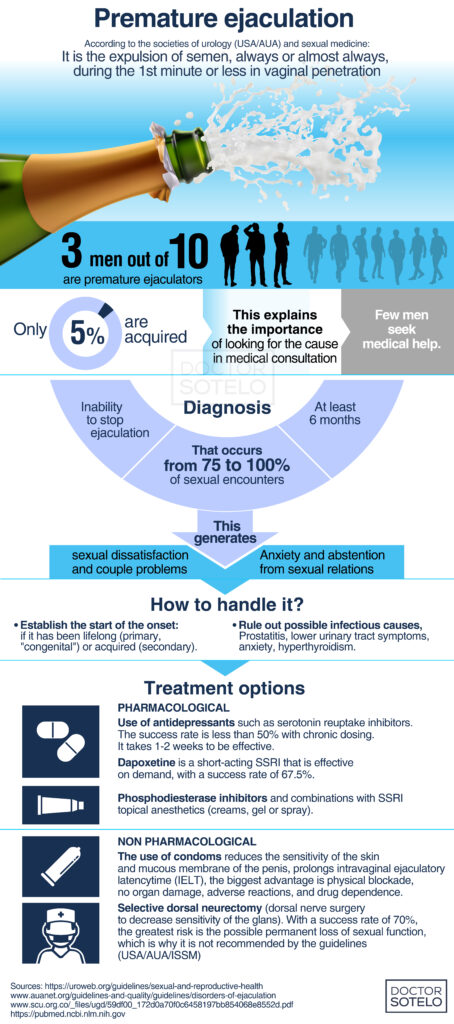PREMATURE EJACULATION (⁴)
- Worldwide prevalence of 30%. (⁴,⁵)
- Only 5% are acquired, which explains the importance of looking for the cause in a medical consultation. (⁷)
- Few men seek medical help. (⁴,⁵)
Diagnosis
According to the societies of urology (USA/AUA) and sexual medicine. (⁴)
- Ejaculation in 1 minute or less during vaginal penetration. (⁴)
- Inability to stop ejaculation. (⁴)
- At least 6 months. (⁴)
- That occurs from 75 to 100% of sexual encounters. (⁴)
- That generates sexual dissatisfaction or couple problems. (⁴)
- Anxiety and abstention from sexual relations. (⁴)
How to handle it?
Establish the start of the onset, if it has been lifelong (primary, “congenital”) or acquired (secondary). (⁴)
- Rule out possible infectious causes: prostatitis, lower urinary tract symptoms, anxiety, hyperthyroidism. (⁴,⁵,⁶)
There are many treatment options available:
- Pharmacological: Use of antidepressants such as serotonin reuptake inhibitors (SSRIs); Ejaculation is modulated by descending supraspinal tracts of various brain regions. Serotonin is involved in the control of ejaculation, and its retarding effects are attributable to the activation of its receptors at the spinal and supraspinal levels. On the contrary, their stimulation precipitates ejaculation. (⁸) The success rate is less than 50% with chronic dosing of 1-2 weeks to be effective. Chronic use causes prolonged increases in serotonin, due to receptor desensitization (⁸). Dapoxetine is a short-acting SSRI that is effective on demand, with a success rate of 67.5%. (⁹)
- Phosphodiesterase inhibitors and combinations with SSRIs (¹⁰) topical anesthetics (creams, gel or spray) are also indicated. (⁴,⁵)
- The use of condoms reduces the sensitivity of the skin and mucous membrane of the penis, prolongs intravaginal ejaculatory latency time (IELT), the biggest advantage is physical blockade, no organ damage, adverse reactions, and drug dependence. Currently there are proposals such as thickened condoms (¹³) and surgical techniques in which an internal condom made of acellular dermal matrix is implanted that improve the IELT(¹²)
- The principle of current surgical treatment is to decrease the sensitivity of the glans; the dorsal nerve is the sensory nerve of the glans and is necessary for normal erection. Selective dorsal neurectomy is reserved for patients resistant to conventional treatments, with a success rate of 70%, increasing the IELT by 3 times, the greatest risk is the possible permanent loss of sexual function, which is why it is not recommended by the guidelines (USA/AUA/ISSM) (¹¹)
Fun fact…
- In mammals, there is evidence that male fertilization success increases with the number of sperm inseminated relative to competitors. Therefore, a higher copulation rate may increase fertilization success under sperm competition by allowing males to ejaculate more quickly and more frequently, thus providing the benefits of increased sperm transfer. Additionally, males prefer a faster copulation rate, which allows them to ejaculate more sperm per stimulation and thus promote greater sperm transport. For species with multiple ejaculations, increased relative testes size is also associated with shorter ejaculation intervals. (¹²)
- Another possibility is that the cupula rate is regulated according to the availability of mature spermatozoa, under this hypothesis, the competition between spermatozoa is the force that drives the evolution of multiple and rapid ejaculations. The high androgen production associated with relatively large testes could drive increased sexual activity, acting synergistically with sperm availability. Testosterone has been shown to have a strong influence on this aspect. (¹²)
References:
1.https://www.ncbi.nlm.nih.gov/pmc/articles/PMC5653911
2.https://www.ncbi.nlm.nih.gov/pmc/articles/PMC3564677
3.https://scielo.isciii.es/pdf/urol/v63n8
4.https://uroweb.org/guidelines/sexual-and-reproductive-health
5.https://www.auanet.org/guidelines-and-quality/guidelines/disorders-of-ejaculation
6.https://www.scu.org.co/_files/ugd/59df00_172d0a70f0c6458197bb854068e8552d.pdf
7.https://pubmed.ncbi.nlm.nih.gov/24848686/
8.https://pubmed.ncbi.nlm.nih.gov/17169440/
9.https://pubmed.ncbi.nlm.nih.gov/34968812/
10.https://pubmed.ncbi.nlm.nih.gov/21771283/
11.https://pubmed.ncbi.nlm.nih.gov/27652223/
12.https://pubmed.ncbi.nlm.nih.gov/30653133/
13.https://pubmed.ncbi.nlm.nih.gov/35280666/
14.https://pubmed.ncbi.nlm.nih.gov/16834849/
15.https://pubmed.ncbi.nlm.nih.gov/14555325/
16.https://pubmed.ncbi.nlm.nih.gov/15312077/
